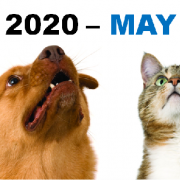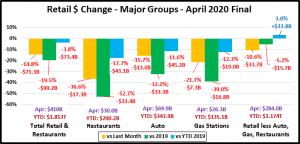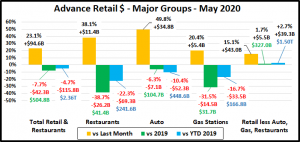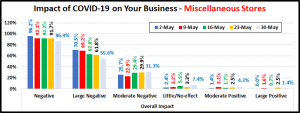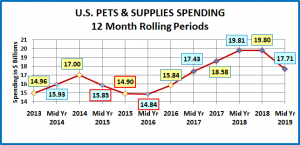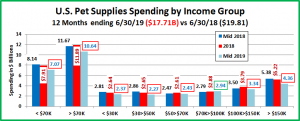Retail Channel Monthly $ Update – April Final & May Advance
Time for our monthly update on U.S. retail sales by channel. The current COVID-19 crisis has caused turmoil in the Retail Marketplace. Consumer spending behavior has changed and continues to evolve. In this report we will track the changes and migration between channels. We will do that with data from two reports provided by the U.S. Census Bureau.
The Reports are the Monthly Retail Sales Report and the Advance Retail Sales Report. Both are derived from sales data gathered from retailers across the U.S. and are published monthly at the same time. The Advance Report has a smaller sample size so it can be published quickly – approximately 2 weeks after month end. The Monthly Final Report includes data from all respondents, so it takes longer to compile the data – about 6 weeks. Although the sample size for the Advance report is smaller, the results over the years have proven it to be statistically accurate with the final monthly reports. The biggest difference is that the full sample in the Final report allows us to “drill” a little deeper into the retail channels.
This means to get the full picture in our monthly channel update we need to look at the latest release of both reports. We will begin with the Final Retail Report from April and then move to the Advance Retail Report for May. This will also allow us to better track the consumers’ evolving spending behavior in terms of channel migration.
Both reports include the following:
- Total Retail, Restaurants, Auto, Gas Stations and Relevant Retail (removing Restaurants, Auto and Gas)
- Individual Channel Data – This will be more detailed in the “Final” reports and we fill focus on Pet Relevant Channels
The information will be presented in detailed charts to facilitate visual comparison between groups/channels of:
- Current Month change – % & $ vs previous month
- Current Month change – % & $ vs same month in 2019
- Current YTD change – % & $ vs 2019
- Monthly and Year To Date $ will also be shown for each group/channel
We’ll start with the April Final report. This was the depth of the crisis (hopefully). The impact is very visible. First, we will look at some major retail groups. (Note: The Data in all graphs is Actual, Not Seasonally Adjusted)
It is slightly better ($8B) than the Advance report projected a month ago. Although Restaurant $ales were $2B less than expected, the “Relevant Retail” segment was $10B better. Gas Stations also were $1B more than the early numbers but The Auto Segment was “spot on”. However, It was still by far the worst year over year monthly performance in history.
In a “normal” April we are generally into the Spring Lift as consumers begin to turn to outside activities. However, the widespread closures and “stay at home” guidelines generally ended that behavior.
Now, let’s see how some Key Pet Relevant channels were doing in April.
- Overall – Any binge spending ended in April as only Internet and Hardware/Farm had a March to April increase.
- Building Material Stores – This group typically has their biggest annual lift in Spring. It appears that this is unchanged. Farm Stores did especially well with spectacular increases in all measurements. Although Sporting Goods stores are not included in this group, they have a similar Spring lift pattern. However, the results are totally different. You truly see the impact of the sports/recreation “shut down”.
- Food & Drug – Although the March binge buying is over, Supermarket sales continue with strong growth. Drug Stores also had a March sales rush on essentials, but that clearly ended in April as sales are below April of 2019.
- General Merchandise Stores – Although the March binge buying is over, sales in $ Stores, Clubs/SuperCtrs are both up, with $ Stores showing the most growth. Most traditional Department stores were closed and shopping in many Discount Department stores was often limited to essentials. The result is that sales were down -44.5% vs April 2019.
- Office, Gift and Souvenir Stores – Most of these stores are deemed non-essential. You see the result.
- Internet/Mail Order – “Stay at home” has further accelerated this channel’s growth. This will likely continue as the crisis has introduced many new consumers to online shopping.
- A/O Miscellaneous – This is a group of small to midsized specialty retailers – chains and independents. It includes Florists, Art Stores and Pet Stores. Pet Stores generally account for 22 to 24% of this group’s total sales. Although Pet Stores were generally deemed essential most stores were not. The group was up 21% YTD in February which is the only reason that they are still “hanging on” to a YTD increase.
April was certainly a terrible month for retail spending, the biggest Total Retail $ drop in history. The March binge/panic buying ended in April and we saw the huge negative impact of a full month of non-essential business closures. In May, a very slow reopening of the economy began. Let’s see how it is progressing. Here are the Advance numbers for May.
April was the biggest spending drop in history. May was $95B better but still $42B (-7.7%) below May of 2019. That gives us an idea of how serious the current situation is and how long the recovery may take.
Total Retail – Total Retail spending fell $42B, -7.7% vs 2019, edging out March for the 2nd biggest drop in history. Remember, 2020 started off strong. Spending through February was up $60B, +6.6% versus 2019. Then came the COVID-19 crisis and now it is down -$116B – a $176B turnaround in just 3 months.
Restaurants – Spending increased $11B over April but was still down $26B vs 2019. The year started out good, up $9B (+8.1%) through February. Then social distancing began, and many restaurants closed. Delivery and curbside pickup couldn’t make up the difference as spending fell $78B in 3 months so this group is now down $69B YTD.
Automobile & Gas Stations – If you can’t go out, except for necessities, then your car becomes less of a focus in your life. Buying a car was definitely less of a priority. Auto Dealers, both new and used, tried to combat this with some fantastic deals and a lot of advertising. It appears to be helping but sales were still down $7B versus 2019. In terms of Gas Stations, May is traditionally the beginning of the vacation travel season but not in 2020. Prices are still down but people are still not driving as much as they used to, whether for commuting or road trips.
Relevant Retail – Less Auto, Gas and Restaurants – Many non-essential businesses began to shutter their doors in March but there was also a rash of binge/panic buying for “necessities” and a big lift in groceries as consumers focused on home cooking which drove spending up $19B. Then came April. With a full month of closures and an end in binge buying, spending dropped $34B, -10.7% from March and 16B, -5.2% vs April 2019. In May, the overall market began a slow reopening so spending began to move in the right direction. Nonstore and Grocery, along with SuperCenters/Clubs & $ Stores continued their growth. The spring lift in the Hardware/Farm channel got even stronger and the group which includes Sporting Goods, Hobby & Book Stores bounced back to beat their May 2019 numbers. The Relevant Retail group now has positive numbers in all measurements – vs last month, last year and year to date.
Now let’s look at what is happening in the individual retail channels across America. In May, consumer spending in the relevant retail market returned to positive numbers. Let’s see where the $ came from. These groups are less defined than in the Final Monthly reports and we will look across the whole market, not just pet relevant outlets.
Every group had a May sales increase over April, but performance was mixed when it came to vs 2019 and YTD.
Observations
April was a full month of stay at home, widespread closures and reduced discretionary spending so it was an easy number to beat. However, only 7 of 13 groups had positive numbers for May 2020 vs 2019:
- Nonstore Retailers – Even more consumers are online shopping.
- Food & Beverage, especially Grocery– Restaurant $ are still down so consumers continue to eat & drink at home.
- Sporting Gds/Hobby/Books – Stores reopened and consumers started to return to outside recreational activities.
- Bldg Materials/Garden/Farm – A big Spring lift as consumers focus “on their home” even more than usual.
- SuperCtrs/Club/Value/$ Strs – Sales slowed in April, but they came back strong in May and it was enough to turn the whole Gen Mdse channel positive. This group of stores offers great value which is still a consumer priority.
Regarding the Individual Large Channels
General Merchandise Stores – Some Regular Department stores began reopening and Discount Department stores held their ground, so this cut the losses for Department Stores. Club/SuperCtr/$ stores provided the big positive force. In April consumers dialed back their panic buying and spending on discretionary items was also down significantly. In May we saw consumer spending return to a more normal pattern in the big and small stores that promise value shopping.
Food and Beverage, plus Health & Personal Care Stores – The Grocery segment is still being driven by increased Food sales due to restaurant closures, up 14.3%, +$8B. Sales in the Health, Personal Care group are up minimally from April but remain down overall. Many Personal Care stores are slow to reopen and Drug Stores sales are essentially flat.
Clothing and Accessories; Electronic & Appliances; Home Furnishings – As stores reopen there was a spectacular increase in sales over April. However, May $ were still down big time from 2019. They all had the same pattern, with Clothing Stores being the most extreme. Their sales were up 209% from April but still down 63% vs 2019 and 43% YTD. These channels have a long way to go to recover.
Building Material, Farm & Garden & Hardware – This channel has its biggest spending lift in the Spring. The shelter in place rules caused many consumers to turn their focus to their needs at home, including house and yard repair and improvement. This has further accelerated the usual Spring lift. Sales are up across the board, including +6.7% YTD.
Sporting Goods, Hobby and Book Stores – Book and Hobby stores which had been closed started to reopen. Sporting Goods stores had generally been open but organized sports were on hold, parks closed, and non-essential travel was discouraged. In May things began to open up and consumers once again sought outdoor recreation. Sales literally doubled from April. The May Sales even beat 2019 by 6%. However, YTD they were still down 10%.
All Miscellaneous Stores – This group is mostly small to medium specialty stores – both chains and independents. While Pet Stores are essential, most other stores in this group are not. The closures hit this group particularly hard. May sales were up 27.3% from April as the reopening began but they are still down 24.3% vs May of 2019. In February they were up $2.6B, +14.3% YTD. In 3 months, this changed to down -$4.3B, -8.3%. That’s quite a negative turnaround.
NonStore Retailers – 90% of the volume of this group comes from Internet/Mail Order/TV businesses. The COVID-19 crisis has only accelerated the ongoing movement to online retail. Compared to 2019, NonStore was up 16.3% in March, 22.5% in April and 25.3% in May. Since April they have been the leader in all sales measurements regardless if it is in $ or % increase. Also, their YTD sales are up 16.6%, exceeding their 12.9% annual increase in 2019. This early year lift bodes well for 2020 as much of their annual increase is usually driven by Christmas Holiday spending, which is still to come.
Note: Almost without exception, online sales by brick ‘n mortar retailers are recorded along with their store sales in their regular channel. Whether they are up or down, their online sales are included in the totals.
Recap – Hopefully, April was the “bottom” in the COVID-19 impact on the American way of life and consumer spending. Although the situation began to improve slightly in May, it still beat out March to register the 2nd biggest year over year monthly retail sales decline in history. Restaurants, Auto and Gas Stations all had big sales increases over April, but they are still struggling. The Relevant Retail segment provided the only true positive as sales were up in all measurements. However, for many segments in this group there is still a long way to go. As the situation evolves, spending will no doubt move back to a more routine pattern – a new normal. No one knows how long that this will take and what long term impact the COVID-19 crisis will have on U.S. consumers’ spending behavior. We will continue to monitor the data and provide you with regular updates as the situation evolves.

